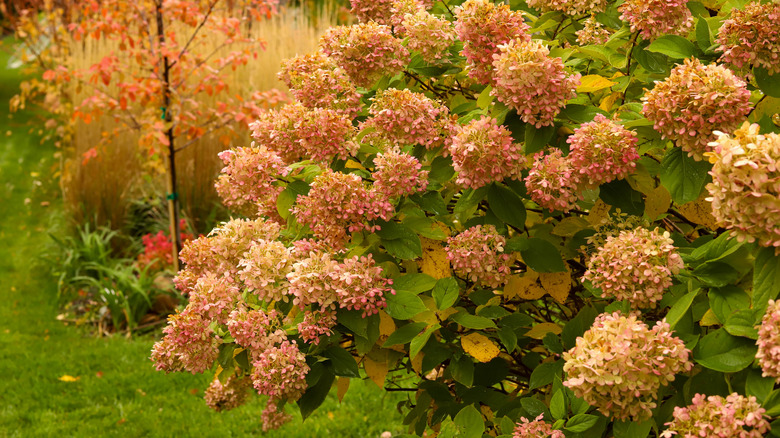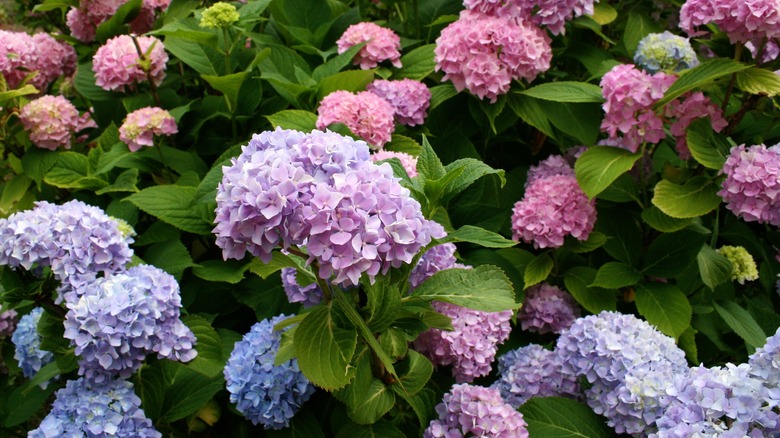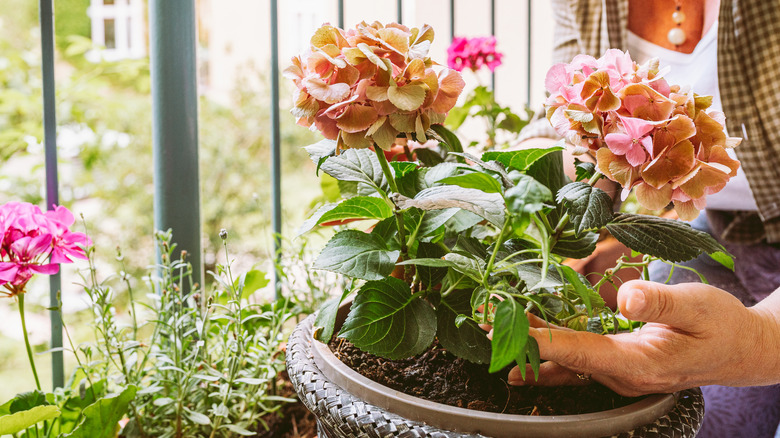Here's How Long Hydrangeas Can Bloom When Grown In And Out Of Pots
Nothing quite says summer like looking at a colorful bush of hydrangea flowers. The soft white, pinks, blues, and purples look picturesque under the summer sun, and yet, the time the flower actually blooms seems rather fleeting. Typically, these colorful blooms flower from mid-spring to early summer, which doesn't seem like a long time for a plant that is so brilliant to look at from your back patio. Nevertheless, there are 70 different species of hydrangeas, and a few are known for lasting longer than those fleeting few weeks, either in the ground or potted in containers. With proper care, these hydrangeas can bloom from late spring until early fall, between April and October.
First and foremost, the hydrangea is a perennial shrub, meaning it will grow back each year after a few months of being dormant during the winter. They typically thrive in USDA zones 3 through 9 (which spans most of the U.S.), though some species prefer hardier, colder climates in the north or warmer climates down south. Luckily, some of the longest-lasting hydrangea species can thrive in a majority of these zones, making them an ideal shrub to add to your landscape. We'll tell you the types to consider and how to grow and care for hydrangeas indoors.
Growing hydrangeas in the ground
Hydrangeas that are planted outside and well taken care of can survive for up to 50 years. While there are many different species, there are three to consider if you want long-lasting blooms. The first is the 'Original Endless Summer' hydrangea, a shrub that grows from late spring until early fall within growing zones 4 to 9. Then there's the 'Penny Mac' hydrangea found in zones 5 to 8 and the 'Let's Dance Starlight' hydrangea in zones 5 to 9 that grows between mid-summer and early fall. These blooms can grow in different colors depending on the pH levels in your soil; a 5.5 or lower will create blue blooms, 5.5 to 6.5 will produce purple, and 6.5 or higher will produce pink. If you want to control the flower color, you can buy a pH adjustment solution for the soil. Experts say to give the plant two years before making adjustments.
A hydrangea plant thrives in moist, well-drained soil; the drained soil helps to keep the flower hydrated during those summer hot spells. Hydrangeas should be well watered throughout the first spring and summer. Experts say at least 1 inch per week is good, whether from the rain or the hose. When the weather gets colder, you'll want to prepare your hydrangeas for winter to ensure a healthy summer garden.
Growing a potted hydrangea
A hydrangea grown in a container will survive three to five years before needing to be repotted or planted outside in the ground. It's time to repot if the plant is proportionally too small for the container or the soil is hardly absorbing moisture anymore. With the correct pot size and proper care, your potted hydrangea can thrive. The best hydrangea species to grow in pots include those from the bigleaf, smooth, panicle, and mountain varieties. Deadhead the flowers to encourage new blooms.
Where's the best place to put the pot? Outdoor hydrangeas have the benefits of nature on their side; they can get plenty of sunlight and rainwater when needed. If you choose to place it indoors, you'll have to provide a similar climate. Hydrangeas need to experience all four seasons; it's a plant that needs to be overwintered and sheltered to avoid frosts that could cause damage. During those warmer months, choose a spot that gets sun in the morning and shade in the afternoon; too much direct sunlight can scorch the plant and cause it to wilt. You want the soil to be well-watered and moist but not soggy, so use a container with drainage holes at the bottom. Be sure to leave 1 to 2 inches between the top of the soil and the container's rim to make sure the water doesn't overflow. Assess your hydrangea in the fall to see if it needs to be repotted.


